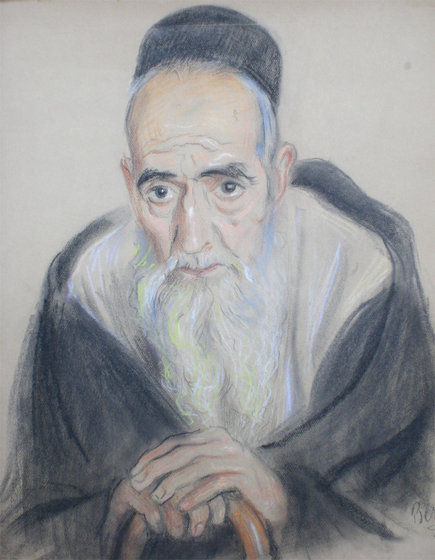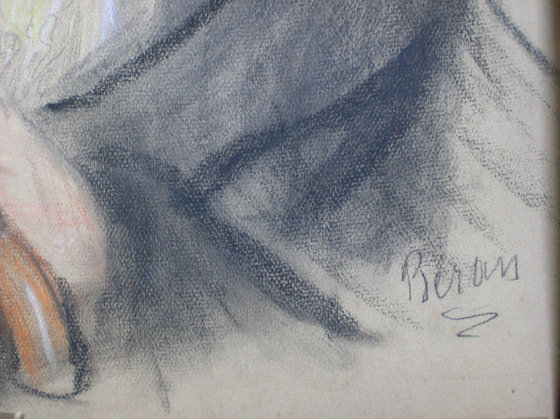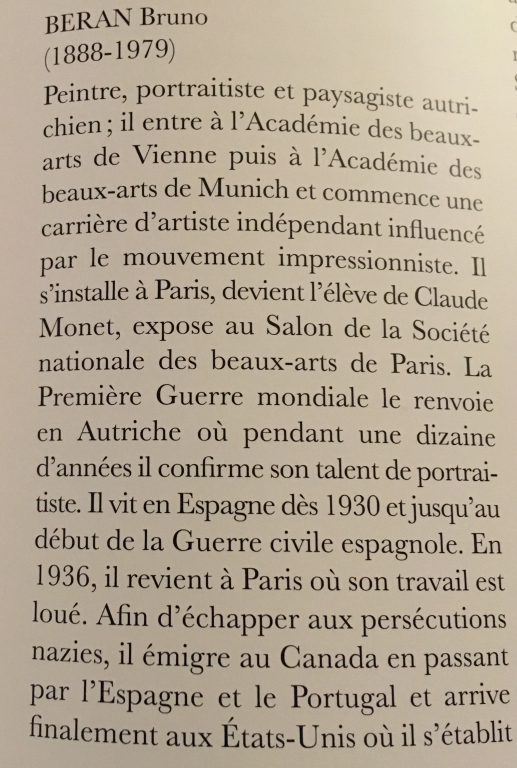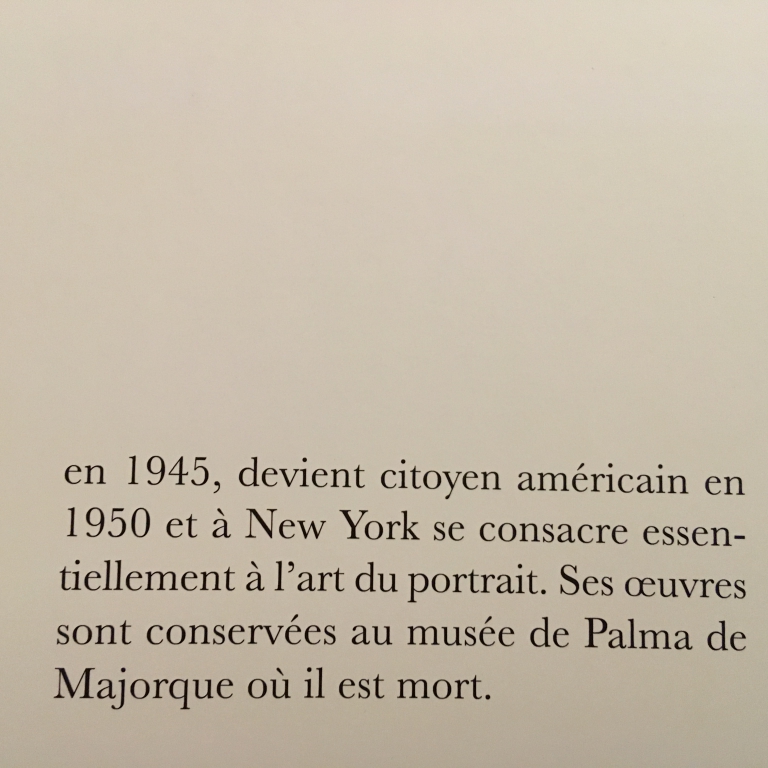VIEUX JUIF MAROCAIN
Beran, Bruno (1888-1979)
| Numéro d'objet: |
22702 |
| Catégorie: |
Tableau / Dessin |
| Technique: |
Fusain |
| Origine: |
Tanger |
| Date: |
1950 |
| Support: |
Papier |
Recherche dans "Notes":
It was 1914 and warclouds were darkening the international horizon. Bruno - the young Austrian - had to flee Paris leaving all his works behind, never to find them again.
Bruno had to join the Austrian army, soon to be discharged with his recurring stomach trouble. Now he installed himself in the attic of his father's factory, converted into a large studio.
Bruno now turned to illustrating his own ideas. Liebstod - depicts love and death competing for a woman. Sinbad - Is one of several illustrations he made to cover stories from 'A Thousand and One Nights'. Note this drawing is in ink - outlines once set on paper can not be erased.
1917/18 the end of World War 1 also saw the breakup of the Austro- Hungarian Empire. Bruenn became Brno inside the new Czechoslovak Republik.
Instead of serving a market of some 100 million people the textile industry of that town was reduced to a home market of some 16 million. The new Nations created by the Treaty of Versailles each put up customs barriers against one another.
I don't think my Grandfather, the originator of the large factory fully reconised the consequences. He was an ailing old man and luckily did not witness the final humiliation when the banks stepped in and took over the factory. They paid off the creditors and shareholders at a percentage, selling the premises to a newer industry of car producers.
The family name and reputation had suffered by these transitions and Bruno and Irene returned to Paris where they rented a studio. My sister followed, whilst I was left behind in the charge of governesses and teachers.
Having lost their home in Bruenn my parents started to travel widely, always carrying the easel, crayons and brushes.
An oil painting of the river Seine. A sketch of Nantes harbour. The famous medieval wooden bridge across the Lake of Luzern. An old corner of Menagio, a village on lake Como.
In 1931 they first crossed into Spain, and Bruno loved the brilliance of light, the friendliness of the people and the low cost of living.
'Cadaqes' - on the Costa brava - nestling around the church of unusual hexagonal construction.
A boat trip from Barcelona took them to the Island of Ibiza. If you know that place you will agree that the old city is a delight to an artist's vision.
Here we have a street scene of women chatting amongst their little white houses, reached by cobbled sreets.
Bruno rented one of the larger, old houses, and transformed it into a studio, and I who had just finished my studies, joined my parents in their new home.
The three years they lived in Ibiza father later descibed as the happiest of his life, so that you can imagine that the outbreak of the Spainish Civil War came as a great shock to them.
On a British destroyer (The Grenville) foreign visitors were asked to leave the Island, and so again he had to abandon all his artistic possessions and we arrived in Tilbury Harbour which for me was the first sight of my new homeland.
My parents were not happy in England and returned to Paris, where my sister had recently married a bankclerk of Swiss nationality.
Three years later we were once more effectively separated, this time by Hitler's hoards overrunning France. Father's pictures were left in the charge of my sister, but they had to flee once more south. This time they were guided on foot across the Pyrenees mountains, at night, by smugglers into Spain.
Mother used to describe this journey very dramatically, being carried shoulder high across rivers, hearing the distant songs of German soldiers in their campsites, Mother called those smugglers "the most honest people she had ever met". Not only could they have murdered them underway, but even all the luggage arrived days later, at an agreed place inside a San Sebastian Monastery.
However the Spanish police caught up with them in a Madrid Hotel - they had entered the country illegally, without papers. Luckily father's art, and the pictures which he recovered intact from the old Ibiza studio brought about their early release, on the understanding however that they would apply for a visa to the New World.
And so in 1942 - the year of the Alamein and Stalingrad - my parents were once again on the move. Even under the stress of those circumstances father still sketched. 17). Here is a Portuguese Fisherman's head, he must have seen on the way to the boat that was to take them from Lisbon to New York.
Those must have been hard times the first few years in the New World. Even mother helped with the finances by cashing in on a certificate she had obtained from the 'Cordon Bleu' in Paris. She now gave cookery classes and even spoke on American Television.
World events are reflected in Bruno's wartime sketches; The Way of Justice. Persecution. A Dove of Peace.The turning point came in Washington, when father's great talent as a portrait artist was reconised and he obtained commissions from famous people of the Diplomatic Corps. A number of these portraits now hang in museums and public buildings on both sides of the Atlantic.
I don't know who Mrs.'W' was(above), nor why this attractive pastel was rejected. 22). I do know the sitter of this portrait. It is of Judge William O. Douglas a very controversial figure in American Legal History. A second portrait of this Judge of the Supreme Court now hangs in the chambers of the Courtrooms in Washington D.C.
For his pleasure Bruno now let his imagination wander more freely. 23 and 24). Those unusual compositions of heads have been created in his Washington Studio. In 1950 Bruno and Irene became American Citizens.
Soon they started to travel once more. They came to Britain and were invited to an Estate near Crieff in Scotland by Lord Orr. 25). Bruno must have been impressed by the trees of the English countryside. 26). On a visit to France they stayed at Honfleur, a charming and picturesque harbour on the Normandy coast. 27). Further south they stayed in the grotesque pilgrimage centre of Rocamadour.
Yet another journey took them to Morocco. 28). Here depicted are the 'Walls of the City of Fez'. In Tangiers he visited the famous 1000 year old synagogue 29). and was allowed to make this picture of its interior 30 and 31). Here too he was taken by the old men of the congregation. I think he painted five of them and assured me that their combined ages was well over 400. 32). It will amuse you the way a Moroccan Jew took his son to market. ( one Horsepower only !)
In 1969, now 80 years old father decided his eyesight to be insufficiently accurate to continue accepting portrait commissions, so he closed the Studio in Washington and returned to his beloved Spain. First they spent some time in Andalucia. 33). Here is a sketch of Ronda, the mountain fortress, also known for the oldest Bull-Ring in Spain. 34). Is a sketch of a street inside a mountain village in the Sierra Nevada, looking down upon the chimneys of the street below.
Finally they returned to the Balearic Islands and settled in Palma Majorca, whilst continuing to paint to his hearts content. He now tried to adjust to the latest styles of abstract art. 35). Can be described as simply decorative, whilst 36). May be trying to tell a story of overcrowding, or simular, which I have not fully understood.
Bruno Beran donated 16 pictures to the 'Museo de Mallorca' an old palace being transformed into a museum. When next in Palma, perhaps you will spare an hour to browse through those lofty halls with exhibits of Phoenician, Roman, Arab excavations apart from the hall dedicated to my father's work.
When mother became ill, Bruno concentrated his entire energy upon her care, and when she died - of old age - in the spring of 1979, Bruno had lost all purpose of living and followed her within weeks - aged 91.







